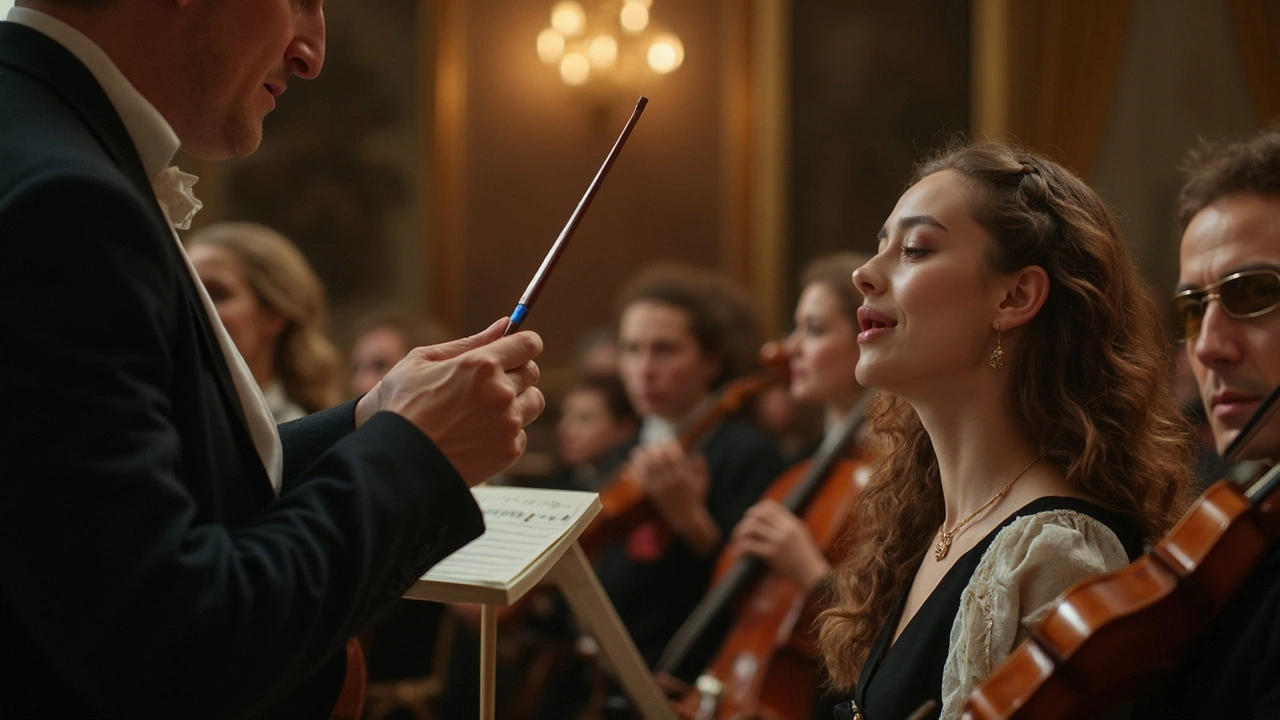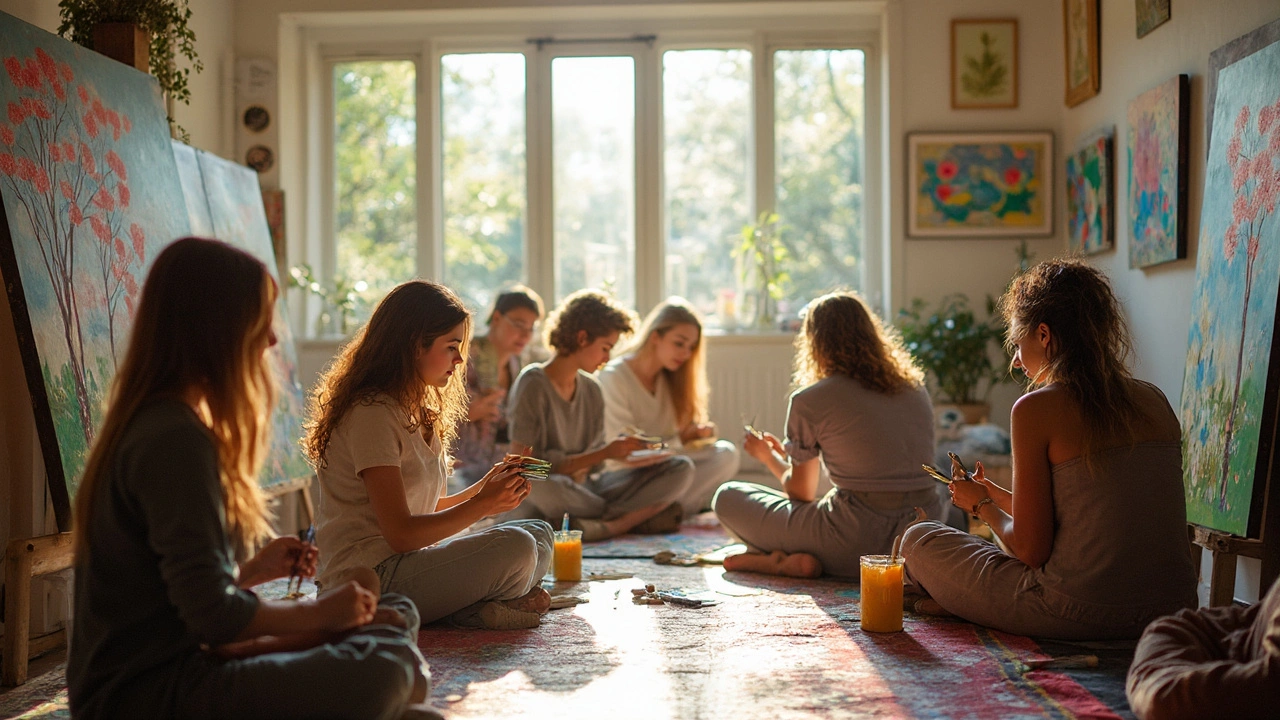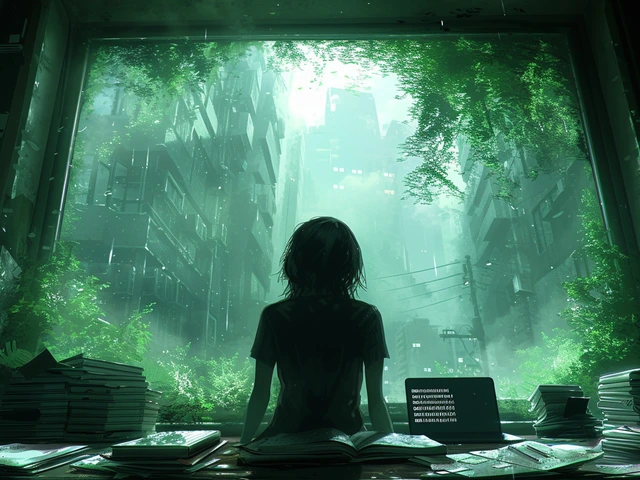Ever wondered if there's a different way to tackle mental health issues, especially if traditional methods haven't quite clicked? Well, meet creative arts therapies—a group of therapies where art isn't just decoration, it's transformation. This isn't your typical therapy session. It's where painting, dancing, music, and drama play starring roles in helping folks better understand and manage their emotions.
Diving into these therapies might sound a bit whimsical, but there's solid science backing their effectiveness. People are using them to combat anxiety, depression, and even trauma. Why? Because when words fall short, art steps up, finding expression where silence once stood.
- Understanding Creative Arts Therapies
- Types of Creative Arts Therapies
- The Science Behind the Benefits
- Success Stories and Case Studies
- Finding a Creative Arts Therapist
- Integrating Therapies into Daily Life
Understanding Creative Arts Therapies
When most people think of therapy, they imagine sitting in a room talking to a therapist. But creative arts therapies are about engaging directly with art forms as a mental health treatment method. These therapies tap into our love for music, dance, drama, and visual arts to help process emotions and improve mental wellness.
What It Involves
Each type of creative arts therapy utilizes a specific art form. For instance, art therapy might have you sketching or painting, while music therapy could involve listening to or playing musical instruments. The idea is simple yet powerful: by focusing on these activities, people often find it easier to express feelings they can't quite put into words.
The Origins
Though it might sound modern, creative arts therapies have been around since the mid-20th century, growing out of a need for alternative therapy approaches. The early pioneers saw that art could foster emotional healing and personal growth, and since then, it's been recognized in therapeutic settings worldwide.
How It Works
The magic happens through expression and release. Engaging with art allows for a non-verbal expression of complex emotions. Ever worked on a drawing and felt the stress lift? It's that effect, multiplied over time, helping people to process trauma, reduce stress, and enhance self-awareness.
Proven Benefits
Research shows significant improvements in patients using creative arts therapies to tackle issues like depression, anxiety, and PTSD. According to a study published by the American Art Therapy Association, patients reported a 30% reduction in depression and anxiety symptoms after just 10 sessions of art therapy.
Why It Matters
- Personalized Approach: Each session is tailored to fit the individual's needs and talents.
- Non-Verbal Expression: Perfect for those who find it hard to talk about their feelings.
- Accessible to All Ages: Whether you're young, old, or somewhere in the middle, there's a therapy tailored for you.
These therapies break down barriers to mental health care, making healing accessible, even to those who balk at traditional methods. By engaging with the creative process, people can change their mental landscape, all through the act of creation.
Types of Creative Arts Therapies
Diving into creative arts therapies reveals a fascinating palette of different approaches. These aren't one-size-fits-all solutions. Each type offers its unique path to healing, tapping into various forms of expression.
Art Therapy
Art therapy is all about using visual art to express feelings that are hard to put into words. Painting, drawing, and sculpting become tools for self-exploration. A cool fact? A study from Drexel University found that just 45 minutes of creative activity can significantly lessen stress hormones.
Music Therapy
With music therapy, it’s not just about listening to tunes, but actively engaging with music. Singing, playing instruments, or composing can boost mood and even alleviate symptoms of chronic pain. Music taps directly into the emotional centers of our brain. According to the American Music Therapy Association, music therapy has been shown to decrease anxiety and build emotional resilience.
Dance and Movement Therapy
Dance and movement therapy isn’t about being a pro dancer. It's about moving your body to release pent-up emotions and promote mental and physical integration. According to a report in the Arts in Psychotherapy journal, participants noted improvement in body image and emotional well-being.
Drama Therapy
Drama therapy builds on role-play and storytelling. It’s a space to explore different characters and scenarios, providing a safe distance to reflect on personal life situations. It’s widely used in schools and hospitals, offering an innovative channel for those who struggle with verbal communication.
"Creative arts therapies enable individuals to delve deeply into unexamined emotions, making them accessible and manageable," says Dr. Theresa Cappoen, a renowned psychologist.
These therapies, offering more than just creative expression, become powerful allies in mental health recovery. Curious about trying them? Different approaches might spruce up your mental health routine, giving you a new avenue to explore and heal.
The Science Behind the Benefits
So, what's the deal with creative arts therapies and why do they work so well? It turns out there's some heavy science behind it, and it's fascinating. These therapies combine psychology, physiology, and neurology to create a kind of whammy effect on the brain.
How It Affects the Brain
First off, when you're engaged in art therapy, your brain pumps up the production of dopamine. That's the feel-good neurotransmitter that boosts mood and can even relieve pain. No wonder people feel better when creating!
But it's not just about dopamine. Studies show these therapies activate the brain's right hemisphere, which is all about creativity and imagination. This helps in processing emotions that are hard to articulate with words, making them crucial for tackling conditions like anxiety and depression.
The Therapy Spectrum
Diving deeper, specific types of creative arts therapies have their own unique benefits. Music therapy, for example, has a profound impact on improving memory and cognitive function. It's used in Alzheimer’s treatments and for patients recovering from strokes.
Dance therapy? It’s a powerhouse for reducing stress, improving self-esteem, and even increasing physical fitness. Plus, it encourages motor skill development and coordination.
Research and Statistics
The effectiveness of these therapies is not just theoretical. A study showed that 77% of participants with moderate to severe depression found relief through creative arts therapies. Another research highlights that art therapy can reduce anxiety levels by up to 30% in just a few sessions.
Real-World Application
Creative arts therapies aren’t just for clinical settings either. Schools are adopting them to help students manage stress and enhance emotional learning. The workplace is also getting on board, with companies introducing art-based activities to boost employee morale.
Bottom line? Creative arts therapies harness the power of art to help the brain rewire and heal. They’re a legit and scientifically backed option for those looking to improve mental health in a meaningful way.

Success Stories and Case Studies
Let's get into the heart of it—real-life stories and actual case studies where creative arts therapies have made a world of difference. These stories are proof that tapping into creativity can genuinely change lives.
A Journey Through Art Therapy
Meet Sarah, a young adult struggling with severe anxiety. Medication and traditional talk therapy only helped her so much. Then she discovered art therapy. Through painting and drawing, Sarah found a new channel to express her feelings. Not only did she start managing her anxiety better, but she also rediscovered her love of art, which became a daily refuge. Art therapy didn't just teach her about colors but helped her see the greys in life with more clarity.
Music Therapy's Transformative Power
Tom, a war veteran, faced nightmares and PTSD. Words were hard, but music wasn't. His therapist introduced him to music therapy, and soon, Tom was learning to play the guitar. Each strum helped him process the trauma locked in his mind. Studies show that music therapy can actually reduce symptoms of PTSD, providing an emotional outlet that language can't always do.
Dance Movement Therapy: Healing Through Motion
Let's not forget Emma, who battled depression after losing a loved one. Dance movement therapy encouraged her to express grief without speaking. Emma spent sessions moving to her rhythm, slowly shedding emotional weight. Emma's case isn't isolated; researchers have noted that dance movement therapy often boosts mood and helps people reclaim joy.
| Therapy Type | Reported Improvement |
|---|---|
| Art Therapy | 60% of clients reported reduced anxiety |
| Music Therapy | 70% noted improved mood |
| Dance Movement Therapy | 55% experienced better emotional regulation |
These stories and figures are not just numbers; they're a testament to the potential of creative arts therapies. If you're pondering if these therapies could be your lifeline—or for someone you care about—then perhaps it's time to take that leap. As these stories show, sometimes you just need a splash of creativity to turn things around.
Finding a Creative Arts Therapist
Alright, so you've decided to give this whole creative arts therapies approach a shot. Awesome choice! But where do you begin? Finding the right therapist can feel like searching for a needle in a haystack, but it doesn’t have to be overwhelming.
The first step is research. Use directories from reputable organizations like the American Art Therapy Association or the British Association of Art Therapists. They have listings of qualified professionals in your area. This ensures you’re getting someone with the proper credentials.
Considerations When Choosing a Therapist
When selecting a therapist, think about the type of creative outlet you're most comfortable with. Do you get lost in music, or is picking up a paintbrush more your style? Choose a therapist who specializes in your preferred activity.
- Credentials and Experience: Check if they are licensed practitioners with a background in psychology or social work alongside their arts expertise.
- Connection: It's important to feel a connection with your therapist. A good rapport makes the process feel less like treatment and more like personal growth.
- Practicalities: Consider logistics like location, session costs, and insurance coverage. These practical things matter for sustainability.
Trying Out the Process
Once you've narrowed down your choices, don’t hesitate to schedule initial consultations. Many therapists offer these for free or at a reduced rate. This is your chance to ask questions and see if their approach aligns with your expectations.
Therapy is not one-size-fits-all, and that's okay. Feel free to explore different options until you find the therapist who makes you feel understood and inspired. Remember, the goal is to discover new ways to express and heal, and the right guide can make all the difference.
Integrating Therapies into Daily Life
Bringing creative arts therapies into your everyday routine might seem like a tall order, but it’s easier than you think. Art and health aren’t just reserved for specialists. You can weave these therapeutic practices into your daily grind without overhauling your schedule.
Start Small
Begin by setting aside time each week—it doesn’t need to be a lot. Even just 30 minutes of dedicated time can make a difference. Perhaps you can keep a sketchpad for doodles or a journal for lyrical poetry where you let emotions flow. These small commitments steadily build a more expressive life.
Make It Personal
Pick an art form that speaks to you. Not everyone is a painter, and that’s alright. Some might find solace in strumming a guitar, while others may enjoy the rhythm of dance. The key is picking what feels least like work and most like an escape.
Join a Group
Another way to integrate these therapies is through community. Joining a group or class doesn’t only improve skills; it connects you with like-minded folks. The social aspect can enhance your experience, providing incredible support networks.
Track Your Progress
Consider keeping a log of your journey with creative arts therapies. It’s incredible to look back and see growth—not just artistically, but in how you handle stress and emotions. Plus, it helps you stay motivated.
Use Everyday Inspiration
Don’t underestimate the power of everyday occurrences. A walk in the park or a favorite movie can inspire art. Let these moments fuel your creativity and therapeutic practice.
Integrate With Other Routines
If meditating or yoga is already part of your day, consider tacking on a short creative session afterward. Mindfulness opens you up, making the creative process more enriching.
Remember, the goal isn’t to be a professional artist, but to enrich mental health and well-being. So, whether you're picking up a paintbrush or writing a new song, know that creative arts therapies can seamlessly fit into your life, supporting mental health in the most colorful ways.






